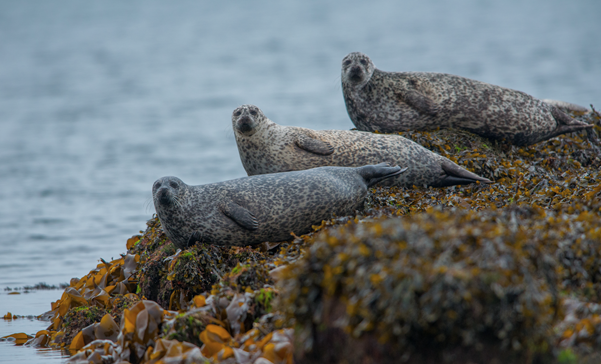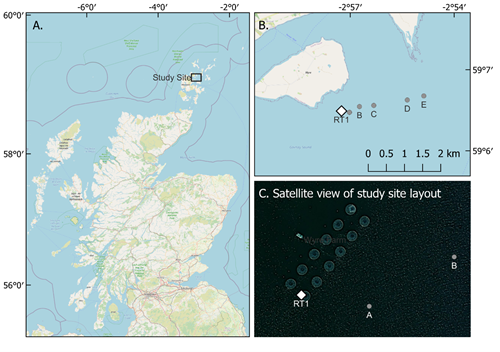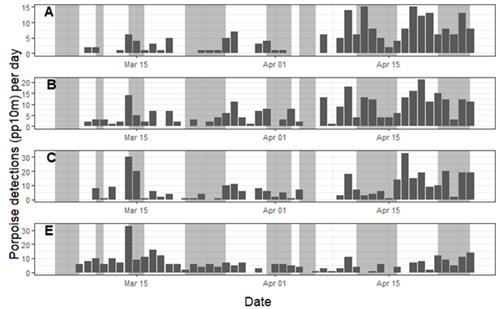Low-frequency deterrent impact on non-target species
Project Summary
Project life: 10 months
This project improved understanding of low-frequency acoustic seal deterrents and how they can be used in a sustainable way that does not impact sensitive marine species. It demonstrated a robust new method for quantifying the potential impact of underwater sound on harbour porpoises, and it also supported future research capacity by investing into scientific equipment.
Alex Coram, Research Assistant, Scottish Oceans Institute, University of St Andrews
Benefit
This project has provided evidence that there is no negative impact on non-target marine species – like porpoises, who are reliant on sound for foraging and communication – when the tested low-frequency acoustic systems are deployed on fish farms. The research will facilitate the grant of EPS licenses across Scottish fish farm sites for these environmentally responsible seal predation mitigation systems.
£132k
Total Value
£69k
Industry Contribution
£50k
SAIC Contribution
£12.5k
Academic Contribution
Partners
-
Ace Aquatec
-
University of St Andrews
-
Scottish Sea Farms
Project leads: Nathan Pyne-Carter, Alex Coram, Richard Darbyshire
Case study
Download Full Case Study PDF
This project has provided evidence that there is no negative impact on non-target marine species – like porpoises, who are reliant on sound for foraging and communication – when the tested low-frequency acoustic systems are deployed on fish farms. The research will facilitate the grant of EPS licenses across Scottish fish farm sites for these environmentally responsible seal predation mitigation systems.
Background
One of the challenges faced by the Scottish aquaculture sector is the predation of farmed salmon by seals at marine net pen sites. Seals attack fish through the net mesh causing both direct injury or loss of fish and indirect losses by stressing fish to the point that they will reduce or even stop feeding and may become more susceptible to health challenges. In addition, seals can damage nets allowing farmed fish to escape, causing financial losses and potential environmental impacts. Losses sustained due to seal predation cost the sector approximately £12 million annually (source: Salmon Scotland), making mitigation efforts an ongoing concern.
Farm managers have not only a moral but a legal obligation to protect fish from injury and stress. Therefore, the sector has developed a range of techniques and management tools to prevent seal depredation, including the use of Acoustic Deterrent Devices (ADDs). These devices emit high-amplitude sound to discourage seals from approaching salmon pens. Commonly used models producing mid-frequency sound in the 10-20 kHz range, which is audible to humans, seals and other non-target species. ADDs are typically used alongside reinforced predator nets that are specially designed to withstand direct strikes from seals; however, predator nets can under some circumstances lead to predator entanglement.
Until as recently as 2021, ADDs were routinely used across the sector to manage seal predation. However, concerns over the potential negative impacts of ADDs on non-target species reliant on sound for foraging and communication led to regulatory changes around the licensing and deployment of such devices. For example, the harbour porpoise, common to the Scottish west coast, produces narrow-band high-frequency clicks for communication and prey detection, and are sensitive to sounds between 250 Hz – 175 kHz (Kastelein et al., 2002). Research suggests that ADDs operating above 5 kHz may be more prone to impacting non-target species, and as a result, farms must now have a European Protected Species (EPS) License or the ability to demonstrate that there is no risk of negative impacts.
In 2015, Ace Aquatec developed the first commercially available low-frequency Acoustic Startle Response device (A-ASR) operating at 1-2 kHz, designed to discourage seals from attacking net pen sites while having minimal impact on non-target species. However, policy regulators for the Scottish Government required validation of the technology to determine the audibility of the low-frequency A-ASR to harbour porpoises and to identify any potential negative effects.
Aims
The overarching aim of this study was to test a Startle Response device (A-ASR) while monitoring the local presence of harbour porpoises to determine if the detection rate of harbour porpoises is influenced by the use of the A-ASR device.
This study was conducted in two parts: (1) acoustic testing of the Ace Aquatec A-ASR device under controlled conditions to determine the amplitude and frequency characteristics, and (2) deployment and testing of the A-ASR device at marine net pen sites.

Sound characterisation and modification of commercial A-ASR device for trial work
The development of the Ace Aquatec low-frequency Acoustic Startle Response device was focused around choosing the most appropriate signal to avoid the sensitive hearing range of the harbour porpoise while keeping in mind that sounds below 0.9 kHz may cause stress to salmon. Previous studies concluded that porpoises do not hear well under 5 kHz and are unaffected by sounds below 2 kHz, making the optimum signal between 0.8-1.2 kHz.
Work done
Commercial A-ASR device software was modified to accommodate lower frequency range (0.8-1.2 kHz) and source outputs for tank testing.
Acoustic recordings of the flextensional A-ASR device were made using a RESON 8150 hydrophone and amplifier at the Neptune Sonar testing facility, with seal deterrent transducers suspended 3m below a floating platform (total water depth 15m). Data was recorded in PAMGuard software.
A series of thirty acoustic measurements were taken around the sound source to characterise the ‘real-world’ acoustic output and the perceived loudness of the sound was compared between species-specific functional hearing groups.
An estimate of the distance from the sound source at which hearing damage* could feasibly occur was calculated, using MATLAB, based on values for perceived loudness between species groups.
*Hearing damage is defined in this context as a change in the hearing sensitivity, termed ‘threshold shift’, which can be temporary (TTS) or permanent (PTS).
Outcomes
Sound characterisation of flextensional A-ASR device was accurately measured at a frequency of 1 – 1.25 kHz.
Calculations suggest that a harbour porpoise would need to remain within less than 17.3m of the flextensional A-ASR device for 24 hours before PTS would occur, or 371.8m for 24 hours before experiencing TTS. A seal would need to stay within less than 7.6m for 24 hours to experience PTS, or within 164.6m for 24 hours before TTS.
Testing at sea: system deployment
Work done
The location chosen for this study was a farm site in Orkney (Figure 1), operated by Scottish Sea Farms. It was selected because of its high density of harbour porpoises in the surrounding area.


Figure 1: Map of the study area showing locations of the sound source (RT1) and the five monitoring stations (A-E) (OpenStreetMap contributors under Open DB Licence)
Flextensional A-ASR device equipment (emitting short, targeted low-frequency sound bursts) was installed on the southernmost fish pen on the site, consisting of a watertight ‘top-box’ mounted to the walkway and a transducer suspended 10m below the surface.
A-ASR device was controlled remotely and switched on and off based on a weekly schedule over a two-month period in March – April 2021, giving an adequate number of observations for each exposure period.
Five passive acoustic monitoring stations (SoundTraps – Ocean Instruments NZ Ltd) were moored at ranges of 225m, 510m, 902m, 1838m, and 2310m (depth range of 15-23m; Figure 1, points A-E) and programmed to record the presence of sound-producing species, sampling at 384 kHz.
Raw acoustic data collected was processed using PAMGuard software and treated in two ‘streams’, one for detecting A-ASR sound and one for detecting high-frequency cetacean (porpoise) sound. Data was further filtered to detect ‘clicks’ or short-duration high-amplitude sounds that could be identified as coming from either ‘A-ASR unit’, ‘porpoise’, or ‘unclassified’.
A custom algorithm was developed to process click data based on the ratio of porpoise clicks to unclassified clicks.
Outcomes
Across the five monitoring sites and three deployments, 574.1 days of continuous high-frequency recordings were collected, totalling 35.6 TB of data.
Harbour porpoises were regularly detected at each of the monitor locations throughout the study, both while the A-ASR was active and inactive. Figure 2 shows the number of porpoise detections per day at each of the recorder locations for the third deployment period.


Figure 2: Porpoise detections per day for each recorder location for March/April deployment 2021; A-ASR active periods shown in grey
The porpoise detection rate was found to slightly decrease at all locations while A-ASR was active, however this was highly variable and therefore not statistically significant (p = 0.64).
Other species of cetaceans, fish and pinnipeds were routinely detected within the study area; however, identification and quantification were outside the study scope.
Impact
Ace Aquatec, together with experts at the University of St Andrews Sea Mammal Research Unit, teamed up with Scottish Sea Farms to tackle the issue of seal predation at salmon net pen sites. Currently, the use of acoustic deterrents in Scotland is under review by Marine Scotland and potential bans may be faced if evidence suggest impacts on non-target species. As a result, the sector is seeing an increase in seal predation-related fish mortalities due to the removal of acoustic deterrents across Scottish farms last year.
This project successfully achieved its main objective to provide substantiated evidence that the low-frequency acoustic startle response device (Ace Aquatec A-ASR), when used in long-term deployments, has little or no impact on harbour porpoise numbers around farm sites. Furthermore, it was shown that the sound output from the device is outside the hearing sensitivity range for the harbour porpoise, meaning that it may only be audible at very short distances.
Commenting on the industry value of the project, Nathan Pyne-Carter, CEO of Ace Aquatec, said: “The project was a success and has provided the requested evidence for Marine Scotland to determine that no negative impact occurs when Ace Aquatec’s low-frequency acoustic systems are deployed on fish farms. This research will facilitate the rapid grant of EPS licenses across Scottish fish farm sites for these environmentally responsible predation mitigation systems.” Pyne-Carter also confirms that “project partners are now exploring a stage two project documenting the effectiveness of these systems at reducing fish mortality from predation, to provide the full picture of efficacy and environmental impact.”
Outcomes from this research are resonating globally, with countries such as Chile, Australia, New Zealand, and Canada – some of which are currently banned from ADD deployment – running or proposing trials with Ace Aquatec to validate the low-frequency acoustic startle response device locally.
Alex Coram, research assistant for the Scottish Oceans Institute, University of St Andrews, described the academic impact of the research: “This project improved understanding of low-frequency acoustic seal deterrents and how they can be used in a sustainable way that does not impact sensitive marine species. It demonstrated a robust new method for quantifying the potential impact of underwater sound on harbour porpoises, and it also supported future research capacity by investing into scientific equipment.”
Furthermore, an incidental – and positive – result of this work was the collection of a high-quality acoustic dataset providing unique and valuable insight into the behaviour of harbour porpoises. This record, although not fully investigated within the project, will form part of a long-term dataset available for exploratory and statistical analyses.
This project has provided a platform for aquaculture stakeholder groups, regulators and the Scottish Government to work alongside one another to tackle a topical issue and strive toward a common goal of environmentally sustainable development.
Additional information
- Coram, A., Ragnarsson, V., Thomas, L., & Sparling, C.E. (2022). Use and Efficacy of Acoustic Deterrent Devices (ADDs) in Aquaculture. Marine and Freshwater Science (Cabinet Secretary for Rural Affairs and Islands Marine Scotland Directorate, part of Marine and fisheries) ISBN 9781804350690.
- Quiet success for pioneering acoustic deterrents (aceaquatec.com)
References
Kastelein, R. A., Bunskoek, P., Hagedoorn, M., Au, W. W. & de Hann, D. (2002). Audiogram of a harbour porpoise (Phocoena phocoena) measured with narrow-band frequency-modulated signals. The Journal of the Acoustical Society of America, 112 (1), pp.334-344.